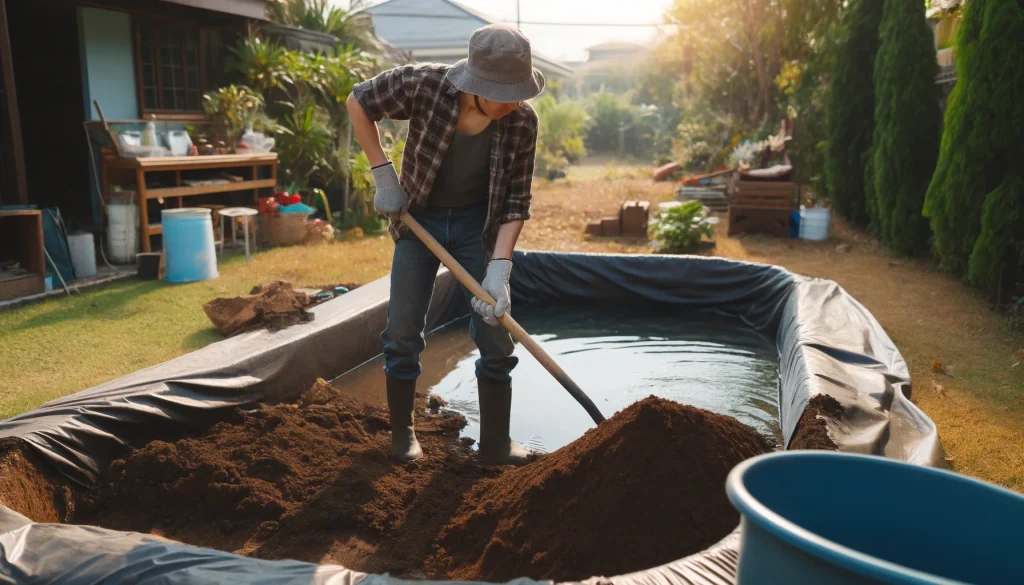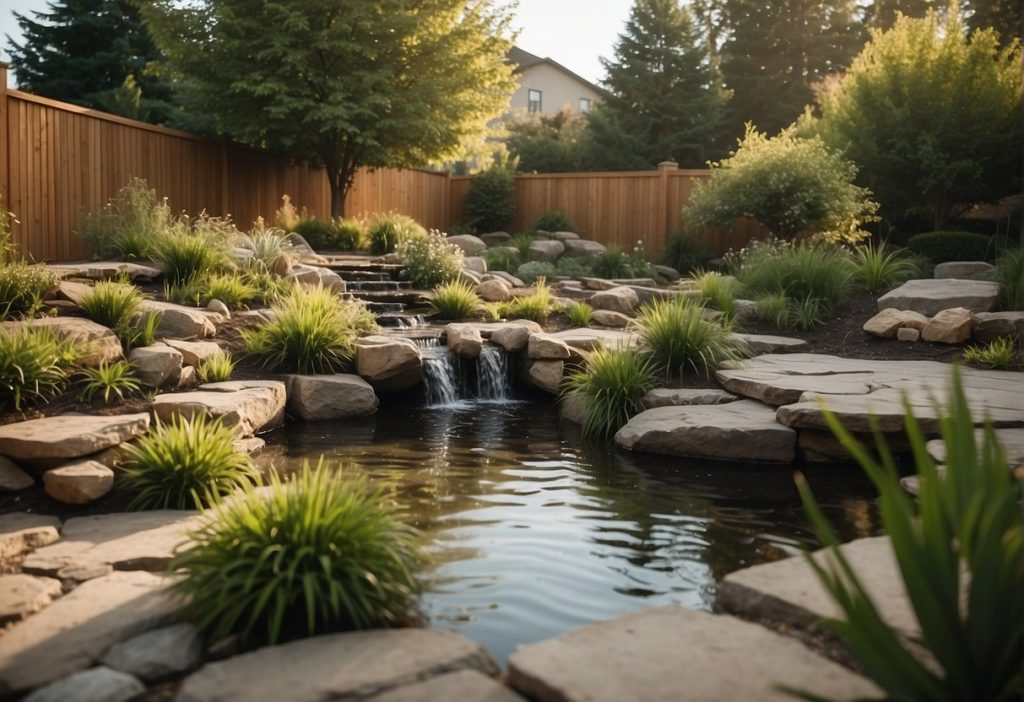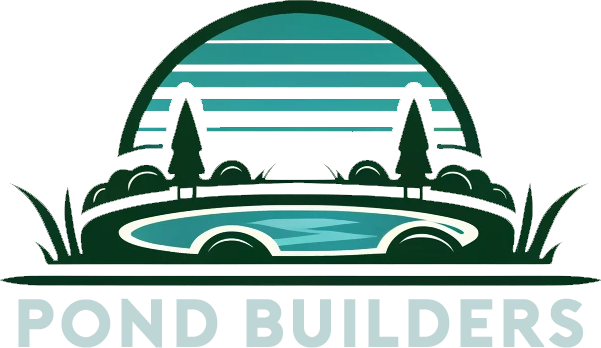Building a backyard pond can be a rewarding DIY project that transforms our outdoor living space into a serene oasis. The calming sound of water and the chance to nurture an aquatic ecosystem provide ample reason to embark on this endeavour. We can create a focal point for our garden, a habitat for wildlife, or a tranquil retreat for ourselves.

We want our pond to thrive for years to come, so choosing the ideal spot is crucial. It’s essential to consider exposure to sunlight, the type of soil, and proximity to trees. Proper location ensures easier maintenance and optimal conditions for any plants or fish we plan to house. Once we’ve nailed down the location, we can channel our creativity into designing our pond—whether we dream of a small, tranquil pool or a larger pond with a waterfall.
Key Takeaways
- A backyard pond adds beauty and tranquility to our outdoor spaces.
- Selecting the right location and designing our pond carefully ensures long-term success.
- Besides the build itself, ongoing maintenance is key for creating a healthy and enjoyable water feature.
Choosing the Perfect Location
When we’re planning to install a backyard pond, it’s crucial to carefully consider the location. We need to weigh factors such as sunlight and shade, convenience, aesthetics, and safety to ensure our pond thrives.
Evaluating Sunlight and Shade
- Sunlight: Ponds need 4-6 hours of sunlight per day, particularly if we’re planning to grow water plants.
- Shade: Too much shade can limit plant growth and too much sun can overheat the water.
We should observe the patterns of sun and shade throughout the day and across different seasons to find a balanced spot.
Convenience and Aesthetics
- Viewing pleasure: Position the pond where it can be easily seen and enjoyed from our favourite outdoor sitting area or a window inside the house.
- Integration: Aim to integrate the pond into the existing garden design. It should complement other features like gardens or pathways.
Safety Considerations
- Security: Ensure the pond is not too close to the property boundary to avoid security risks.
- Fence: If there are children or pets, it is essential to have a barrier such as a fence around the pond for safety.
Designing Your Pond

Before we start digging, it’s important to plan our pond meticulously to fit our aesthetic desires while ensuring a healthy environment for plants and wildlife.
Determining Size and Shape
The size and shape of our pond depend on the available space in our backyard and personal preferences. A typical garden pond can start at about 2 metres in length and width, but we can customize it to any dimensions we wish. There are various pond designs to choose from:
- Rectangular or square: Formal and geometric
- Circular or oval: Smooth, rounded edges for a softer appearance
- Irregular, mimicking a natural look
- Depth is crucial, especially if we’re considering fish like koi; a depth of 60 cm is good for small ponds, while we should aim for at least 1 metre for koi ponds to provide a suitable habitat through Canadian winters.
Creating a Balanced Ecosystem
For a thriving ecosystem, we need to balance oxygen levels, aquatic plants, fish, and bacteria:
- Aim for plant coverage of 60-70% to limit algae growth and provide habitat for wildlife.
- Install a pump and filter system to keep water clean and oxygenated.
- Consider bacteria additives that help break down fish waste and plant material, contributing to water quality.
Selecting the Right Plants and Fish
When stocking our pond:
- Choose native aquatic plants as they require less maintenance and support local wildlife. Examples:
| Recommended Plants |
|---|
| Water lilies |
| Horsetail |
| Duckweed |
| Pickerel |
- For fish, consider cold-hardy species that can survive Ontario’s variable weather:
| Fish Type | Attributes |
|---|---|
| Koi | Colorful, can grow large; need more care |
| Goldfish | Smaller, hardier; easier to manage |
| Shubunkins | Hardy, beautiful colouring |
Gathering Your Materials

Before we start building our backyard pond, let’s make sure we have all the right materials on hand. Remember, choosing quality items saves us time and hassle in the long run.
Choosing a Pond Liner
Our pond’s success hinges largely on the liner, as it’s the barrier that holds the water in place. For most backyard ponds, EPDM liners (ethylene propylene diene monomer) are a popular choice, since they’re durable and flexible. We should measure our pond area to determine the size of the liner needed. Plus, we can’t forget an underlayment which provides a protective cushion for our liner against roots and rocks.
Selecting a Filtration System
Keeping the water clear and our pond life healthy depends on a robust filtration system. There are two main types: mechanical and biological. Sometimes, we’ll see them combined in comprehensive pond kits. Here’s a quick breakdown:
- Mechanical Filters: Capture debris and require regular cleaning.
- Biological Filters: Use bacteria to break down toxins in the water.
Select a filter capacity that matches or exceeds the volume of our pond.
Pumps, Pipes, and Fountains
Finally, we need to set up the pump and pipes. The pump keeps water moving and oxygenated, crucial for fish and plant health. For a touch of elegance, we can add a fountain. Here are a few specifics:
- Pump: Ensure its flow rate matches our pond’s volume and filter requirements.
- Flexible Tubing: This connects the pump to our pond filter and possible fountain or waterfall.
Digging and Installing Your Pond
Before we get started with the actual work, it’s critical to know that proper digging and installation of your pond will ensure its longevity and prevent future complications. We’ll need a good shovel for digging, a quality liner for waterproofing, and an assortment of sand, rocks, and gravel for structural support and aesthetics.
Excavating the Site
When we dig the pond, the first step is to outline the desired shape on the ground using a hose or a rope. As we begin the excavation, we’ll create a ledge around the perimeter, which will later support the edge stones and planting. The depth of the pond should vary, with at least one part reaching the recommended deep zone for overwintering fish if you plan to have them. It’s often advised to dig a few centimetres deeper than the desired final depth to allow room for the underlayment and liner.
- Outline Pond Shape: Hose or rope
- Digging Depth: Variable; deeper section for fish habitation
- Additional Ledge: For edge stones/plants
- Extra Depth: Allowance for underlayment and liner
Installing the Liner and Underlayment
Once the hole is dug, we’ll lay the underlayment to protect the pond liner from punctures. The underlayment can be a special geotextile fabric or even old carpets that provide a cushion for the liner. Next is to install the liner, which should be a durable, fish-safe material that withstands Canadian weather. We spread it evenly over the hole and gently push it into contours, ensuring there are no folds or wrinkles that can weaken the liner’s structure.
- Underlayment Placement: Protects from punctures
- Options: Geotextile, old carpet
- Liner Installation: Durable, fish-safe material
- Ensure smooth placement, no folds
Adding Rocks and Gravel
We’ll add rocks and boulders around the perimeter and on the ledge to secure the liner’s edges and provide a natural look. Rocks should be strategically placed to create a stable edge and to hide the liner from direct sunlight, helping to extend its life. After positioning the larger elements, we’ll distribute gravel on the pond floor, which aids in the colonization of beneficial bacteria and gives an aesthetic finish.
- Secure Liner Edges: Use rocks and boulders.
- Liner Protection: Place strategically placed rocks.
- Gravel on Pond Floor: For beneficial bacteria, aesthetics.
Landscaping and Decor
In this section, we’ll guide you through enhancing the beauty of your backyard pond with complementary plants and decor that not just add to the visual appeal but also promote a healthy pond ecosystem.
Surrounding the Pond with Plants
When selecting plants for around our pond’s edge, it’s important to choose species that thrive in our Canadian climate. Shallow water plants like marsh marigold and Canadian waterweed are great options, offering lush foliage and blooming flowers. We can create a natural look by placing boulders and flagstones as transition elements between the pond and the rest of the garden, ensuring a seamless integration. Here’s a simple plant arrangement to consider:
- At the water’s edge: Plant a mix of creeping Jenny and sweet flag to provide cover for pond life.
- Behind pond-edge plants: Choose taller plants like cardinal flowers and ferns to create a backdrop.
- Around boulders: Tuck in hostas and sedges that will soften the hard lines of the rocks.
Incorporating Lighting and Accessories
Proper lighting enhances our pond’s ambiance at night. Solar-powered lights are eco-friendly and can be placed around the pond to illuminate pathways or spotlight certain features. Below is a table showing types of lights and their best use:
| Type of Light | Best Use |
|---|---|
| Underwater LED lights | Highlighting water features |
| Floating lights | Accentuating floating plants like water hyacinths |
| Spotlights | Focusing on statement plants or boulders |
Accessories like a water feature, such as a small fountain or waterfall, not only serve as a focal point but also help circulate the water, maintaining a healthy pond environment. We can add a personal touch with whimsical figures or a bench nearby for seating to enjoy the tranquil sounds of our water feature.
Maintenance and Enjoyment
We’re going to focus here on how to keep our backyard pond sparkling and healthy, and how we can best enjoy it through the seasons. Proper maintenance ensures good water quality and the wellbeing of any fish we might have. Let’s dive into the specifics.
Regular Cleaning and Care
In our day-to-day pond care, it’s crucial to keep an eye on water quality to prevent algae blooms. We can do this by regularly checking and cleaning our filter and skimmer. Here’s a simple checklist to follow:
- Daily: Inspect the pond pump and skimmer for debris.
- Weekly:
- Clear out leaves and other organic matter.
- Test water quality for pH levels and clarity.
- Add beneficial biological additives if needed.
Seasonal Pond Maintenance
As the seasons change, so do our pond maintenance tasks:
- Spring:
- Clean the pond bottom to remove sediment.
- Check and restart the pump and filter system.
- Introduce or increase beneficial bacteria to balance the pond.
- Fall:
- Prepare for winter by removing any decaying plants.
- Install a pond heater if necessary to prevent ice from fully covering the surface.
